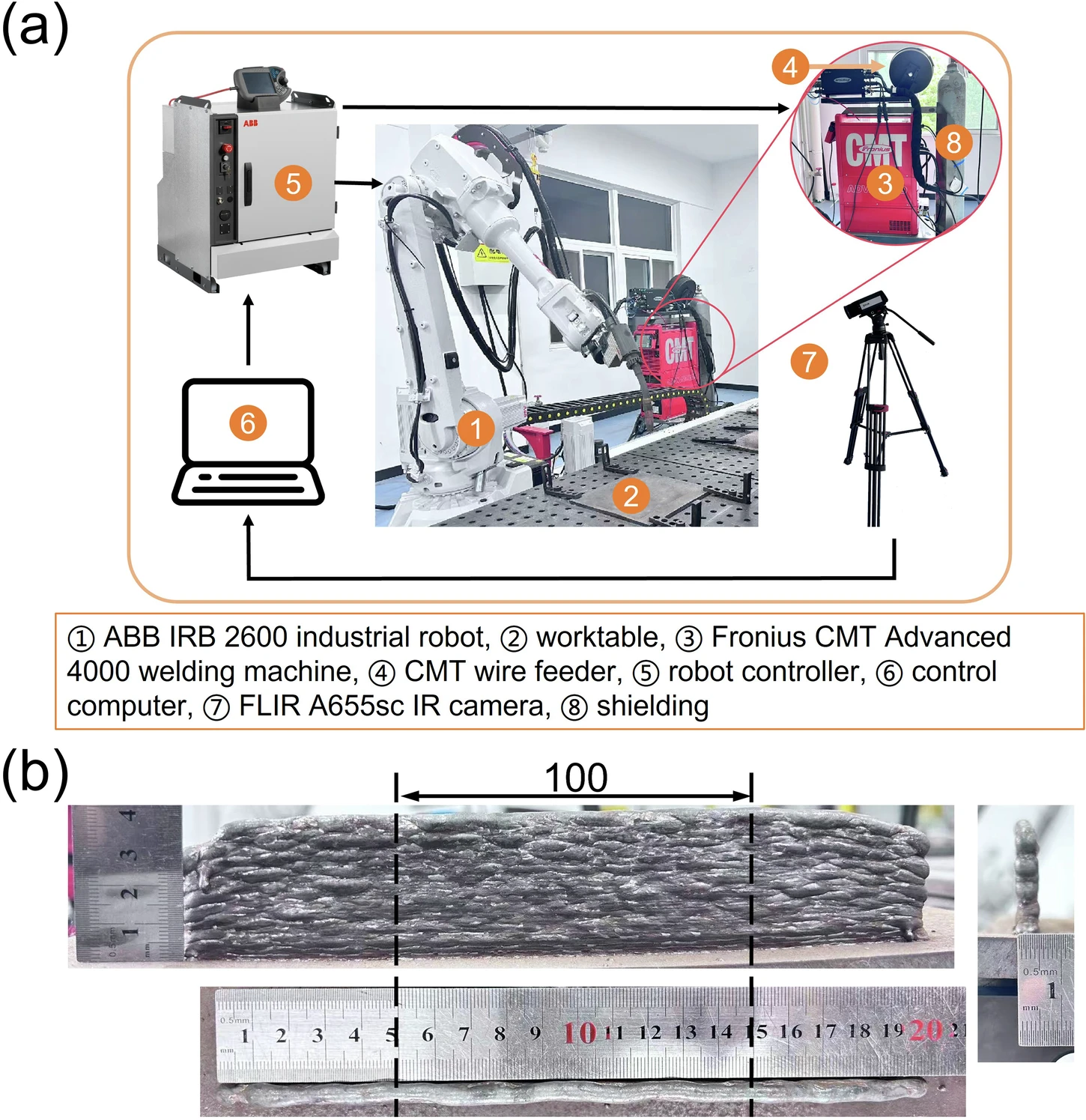What’s better than spotting an A-lister at a fashion show? Seeing an A-list couple, because it’s twice as nice, of course! Tonight, the Vogue World 2025: Hollywood show—which celebrated the intersection of fashion and film, and was held on…
Blog
-

New research shows how AI predicts temperature in metal AM
Researchers at Nanjing Tech University have created an AI model that predicts metal temperatures in real time during 3D printing, offering a way to improve the consistency and quality of 3D printed parts.
Led by Mingxuan…
Continue Reading
-

Transcriptome Sequencing Identifies PCK1 and IRS4 as Key Regulators of
Introduction
Gestational Diabetes Mellitus (GDM) is one of the most prevalent metabolic disorders during pregnancy, affecting approximately 24% of pregnancies in Beijing, with incidence rates rising due to increasing obesity and advanced maternal…
Continue Reading
-
Google confirms huge Pixel 10 update to fix gaming performance – samaa tv
- Google confirms huge Pixel 10 update to fix gaming performance samaa tv
- Frame drops, glitches, battery drain: Gaming on the Pixel 10 isn’t pretty right now Android Authority
- Google says Pixel 10 graphics performance will get better with future…
Continue Reading
-
AWS’ RTB Fabric marks a new front in the battle between Amazon and Google
Google and Facebook may be collectively referred to as “the duopoly” in recognition of their status as the two most prominent companies in terms of ad spend, with Alphabet firmly on top and Meta a close second.
It’s been that way for years, albeit precise numbers are hard to come by. Still, astute market observers (as most Digiday readers are) will be aware that there’s a third (fast-rising) player in the mix: Amazon, with its accouterment of services and data.
On Thursday, it tipped its hand for what is arguably its secret weapon in this Madison Avenue dogfight: Amazon Web Services. The launch of RTB Fabric — a real-time bidding service designed for ad buyers and sellers — represents a calculated push to assert its presence in the ad tech ecosystem by leveraging its dominance in the crucial field of cloud computing. Never mind what happened even earlier in the week.
It also marks a strategic countermove against Google Cloud Platform — the ad giant’s AWS competitor — which has spent the past three years gaining ground among major ad tech companies by better aligning its infrastructure and ad operations, according to sources.
AWS’ pitch and strategic calculus
AWS is pitching RTB Fabric as a scalable, cost-efficient way for ad tech firms to run the high-frequency auctions that underpin digital advertising. For years, only companies large enough to build proprietary real-time bidding systems capable of handling millions of bid requests per second could compete in this arena.
AWS now aims to lower that barrier, positioning itself as a neutral yet ad tech-optimized infrastructure provider. With its move into RTB infrastructure, the company is expanding its product catalog and ultimately defending a lucrative customer base, according to Digiday sources.
Ad tech firms have historically been among AWS’ largest enterprise customers, drawn by its reliability and breadth of services — again, let’s not talk about earlier in the launch week of RTB Fabric. For many, as Google began offering incentives to migrate to GCP — including generous compute credits — in recent years, AWS risked losing one of its most data-intensive verticals.
“Google came in swinging pretty hard in the last three years,” said one industry executive who participated in RTB Fabric’s beta program, and interpreted the latest program as “AWS’ pushback” to GCP’s recent successes. “A lot of them [ad tech companies] have switched to GCP.”
The bet AWS is making is that by co-locating ad transactions within its cloud, companies can cut latency and data-transfer costs, enabling faster auctions and fewer dropped bids — critical factors in programmatic advertising. If two partners are on AWS within the same data center, they can communicate in microseconds rather than milliseconds, noted several sources.
Separate sources with knowledge of the AWS beta, all of whom requested anonymity to maintain relationships, informed Digiday that AWS has received feedback urging it to expand the services to span multiple regions to unlock larger-scale efficiencies.
One noted how a lack of geographic expansion could limit early gains. “Right now, it’s not at a regional level,” they said. “If one partner’s data center is in Ireland and the other’s in Frankfurt, [Germany], you don’t get half the potential benefit.”
An ad tech marketplace
Beyond speed and cost, RTB Fabric also hints at a longer-term ambition: transforming AWS into a marketplace for ad tech modularity. Insiders describe it as an open system where third-party services — ranging from fraud detection to data enrichment — can be integrated directly. “They came to the table and said, ‘What do you want to bring into the marketplace?’” noted one executive. “If you build a module that fits the framework, you can plug it in.”
For some, this “plug-and-play” openness differentiates AWS’ approach from Google’s, which is often perceived as vertically integrated and less interoperable, per several sources. That modular, open-market design is likely to appeal to an ad tech industry wary of over-dependence on Google’s ecosystem — especially as Google faces antitrust scrutiny over its advertising stack. By positioning RTB Fabric as infrastructure-agnostic, AWS can align itself with the sector’s broader shift toward decentralization and interoperability — buzzwords that carry both technical and political significance.
Isaac Schectman, svp of engineering at Sovrn, noted that the supply-side outfit would keep an eye on Fabric RTB’s development, even if it is still early days for the rollout. “We’re excited about the potential benefits that this solution can bring,” he added.
Meanwhile, Joel Meyer, svp of engineering at supply-side outfit OpenX — a company that notably inked a multi-year contract with GCP several years ago — AWS’ RTB Fabric demonstrates the value of cloud computing in the current ad tech landscape, where pressure to act fast and bring new solutions to market is paramount.
“They’re working to abstract a bunch of the complexity that’s involved in running something in the RTB space… If it’s successful, I assume it will put pressure on Google to do something similar,” he said. “Cloud is all about removing the barrier to entry, whether it be scaling up AI solutions, real-time integrations, and this is another step in that direction of making it easier for people to innovate in the RTB space.”
Incentives to scale
As with any platform play, AWS’ challenge will be scale, as its beta-testers account for only a small slice of the global ad tech market. Success will depend on convincing a critical mass of partners to adopt RTB Fabric simultaneously.
And here, AWS appears ready to borrow from Google’s playbook, with cloud-usage credits — effectively subsidies for experimentation and migration — expected to play a significant role. “They’ll likely offer packaging deals with other AWS services,” said one executive, noting how such incentives are standard practice.
Bundling RTB Fabric with services, such as data-processing tools, could make AWS indispensable to the next generation of programmatic innovation, where AI increasingly powers bidding strategies.
Cloud rivalry enters a new phase
The launch of RTB Fabric signals a new phase in the cloud-computing rivalry. According to Synergy Research and CRN’s latest data, AWS still commands about 30% global market share, compared with 20% for Microsoft Azure and 13% for GCP. Yet Google’s gains have been concentrated in advertising and analytics-heavy workloads, precisely where AWS has historically underserved clients.
AWS’ move acknowledges that the ad tech sector, while niche compared to retail or finance, is strategically valuable: it generates massive, always-on data traffic, creates sticky infrastructure dependencies, and influences adjacent industries like media and retail media networks.
For Google, the challenge is existential, with the latest launch interpreted as Amazon’s response to GCP’s increasing courtship of ad tech in recent years. One source, who exchanged anonymity for candor, informed Digiday that GCP execs have openly talked with prospective clients about how it can make its products work.
AWS, by contrast, can offer ad tech players a perception of neutrality — a powerful draw for companies wary of hosting their data on a direct competitor’s stack. Albeit, only the most naive will believe that Amazon’s motivations are anything other than self-interested, ergo buyer beware.
A subtle but significant shift
Executives close to the beta argue that AWS’ entry shouldn’t be framed as a “war,” but rather as an evolution of market structure, with the latest launch, arguably, an extension of Amazon’s “customer-obsessed…” mantra now being extended to the ad tech sector of its AWS clientele.
Still, the symbolism is hard to ignore. AWS is now explicitly marketing a product built for ad tech use cases, not just repurposing general cloud tools. It’s a signal to the industry — and to Google — that the world’s largest cloud provider is no longer content to sit out a sector that underpins the economics of the modern internet.
As one participant summed it up, “For partners on AWS, this could be a no-brainer way to save latency and cost. But the real question is how much scale they can achieve?”
Another source noted, “I don’t think it’s [RTB Fabric] a huge lever for moving people, but I think it’s a bigger lever for getting smaller players off on-premises [infrastructure] into one of the other spaces [of cloud deployments].”
Continue Reading
-

Gustave Caillebotte Masterpieces Come to Louis Vuitton NYC Flagship
PARIS — Louis Vuitton’s temporary flagship on 57th Street in New York City boasts special features including a restaurant and towers of trunks — and for the next three weeks, it will also host a couple of museum-grade paintings.
The…
Continue Reading
-

Redeem Codes for October 27, 2025, Available Now; Here Is How You Can Claim the In-Game Items
In Garena Free Fire Max, players can unlock rewards like skins, diamonds, and weapons by redeeming codes. Check out the latest codes for October 27,…
Continue Reading
-

OpenAI developing new generative music tool capable of creating compositions from text and audio prompts
OpenAI is reportedly developing a new artificial intelligence tool designed to generate music from text and audio prompts, according to a report by The Information.
As per a report by TechCrunch, sources familiar with the project said the upcoming…
Continue Reading
-

Life expectancy gains have slowed sharply, study finds
A new international analysis led by a University of Wisconsin-Madison professor reveals that the remarkable gains in life expectancy seen across wealthy nations during the early 20th century have slowed dramatically. The findings indicate that no…
Continue Reading
-

Michigan neurosurgeon says women face higher risk of neurological disorders than men: Warning signs that ‘go unnoticed’
According to World Health Organisation, migraine is more common in women, possibly ‘because of hormonal influences’. Even medication-overuse headaches, the most common secondary headache disorder, may affect up to 5 percent of some…
Continue Reading
